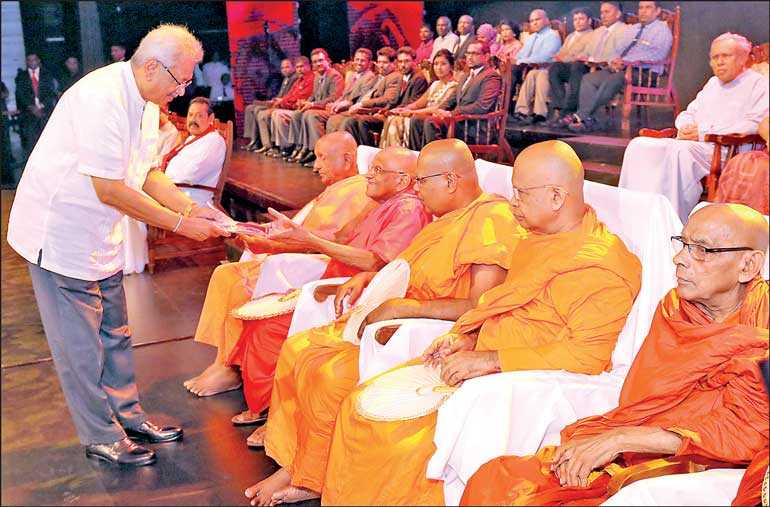Wednesday Dec 31, 2025
Wednesday Dec 31, 2025
Tuesday, 29 October 2019 00:00 - - {{hitsCtrl.values.hits}}

The manifesto of Gotabaya Rajapaksa was released last week and it is important to understand the good parts of it, what could have been better and also what he should keep in mind at the time of implementation, if he is elected on 16 November.
What’s good
There are few factors that are very encouraging. The emphasis on development of human resource was the most prominent. It clearly identified that ‘significant’ investments would be made on  tertiary/higher education. This should be with the ambition of creating high paying jobs which could be achieved by penetrating global markets via high growth industries.
tertiary/higher education. This should be with the ambition of creating high paying jobs which could be achieved by penetrating global markets via high growth industries.
It is also mentioned that a ‘people centric economy’ would be created. This could possibly mean that economic development could be oriented in a manner where a larger proportion of the people would benefit directly rather than indirectly. One would hope that it is a deviation from the 2009-2014 economic development direction, which was more focused on infrastructure such as highways and roads, which was not a direct benefit to the wider population.
It also rightly identifies the grave problem of external current account deficit and has stated to address it through a combination of promoting foreign currency earnings and substituting imports.
What’s missing
At a basic level, it falls to the category of election manifestos from the past. It tries to cover a whole heap of areas. However it does not go into sufficient depth in terms of any of the areas.
For instance, I would have liked to see an identification of resources needed (predominantly how much of funding, but also in terms of human resources, etc.) and a specific plan identifying timelines for milestones. Ideally it should have also explained how the funding and other resources would be sourced. Also, I would have preferred to see a prioritisation – which factors would be given prominence. With the limited resources available and the time constraint of five years, achieving a comprehensive list of objectives is almost impossible.
The manifesto gives the objectives of GDP growth in excess of 6.5%, inflation under 5% and a budget deficit under 4% of GDP. To me, going by the aspects covered in the manifesto, these objectives are contradicting and almost impossible to achieve. If an attempt is made to curb inflation under 5% and budget deficit under 4% of GDP, I don’t expect GDP growth to exceed anything beyond 4-5%. The experience from 2009-2014 also confirms this. While 2010-2012 saw a rapid growth subsequent to the ending of war, it fell to 5% in 2013-2014. In other words, that strategy didn’t result in a sustainable high growth and was not able to beat 5% in the long run.
The priority should be given to revive growth. A growth of 5-6% maybe achieved if inflation and budget deficit is allowed to deteriorate slightly.
What should be done during implementation
Assuming Gotabaya Rajapaksa is elected to power, I wish he would be mindful of the following factors.First and foremost, the most critical objectives to be achieved during the five years should be identified, and given priority. One could understand the need to give a comprehensive list of objectives prior to the election as otherwise natural criticism could be generated from segments of the society which could be exploited by political opponents.
However at the time of implementation a more prudent approach should be taken. Trying to achieve too many things would result in achieving almost nothing as we have seen in the recent past.
The most important factor to realise
The fundamental problem I have with this manifesto is the fact that it is a bottom up approach. As the document itself states, they have consulted many segments of the society to identify their problems and the plan had been devised to address those. In other words, it is a plan devised internally with little evaluation of global trends and factors that could be beneficial to us. The critical factor to realise is, an approach based on solving domestic problems would not be very successful, simply due to the limitation of domestic resources. In other words, as I said before, GDP growth is unlikely to pass 6%, even if inflation and budget deficit is allowed to deteriorate slightly.
To be more specific, would the development of human resources automatically develop industries and drive economic growth? Relying purely on global supply and demand conditions is not easy as the global market is quite competitive. We are competing with other capable countries such as Vietnam, Indonesia, Malaysia, etc. Therefore the success rates would not be great and hence the rationale that we would not be able to beat a GDP growth of 6%.
If we are to reach a sustainable growth of 7-8% or higher, we need two important factors: Access to technology and a captive market. It is by exploiting and utilising global trends and factors that we could accomplish those two factors. That’s why it is imperative to understand the geo-political factor of the great interest of China and USA on Sri Lanka in recent times. The economic strategy for the next five years spelt in my book ‘A simple plan for Sri Lanka’ is also centred around that aspect.
I hope that if elected, Gotabaya Rajapaksa and his advisors realise this great opportunity and adjust their strategy over the next five years, so that Sri Lanka could reach a developed state in our lifetime.
(The writer could be contacted on [email protected].)